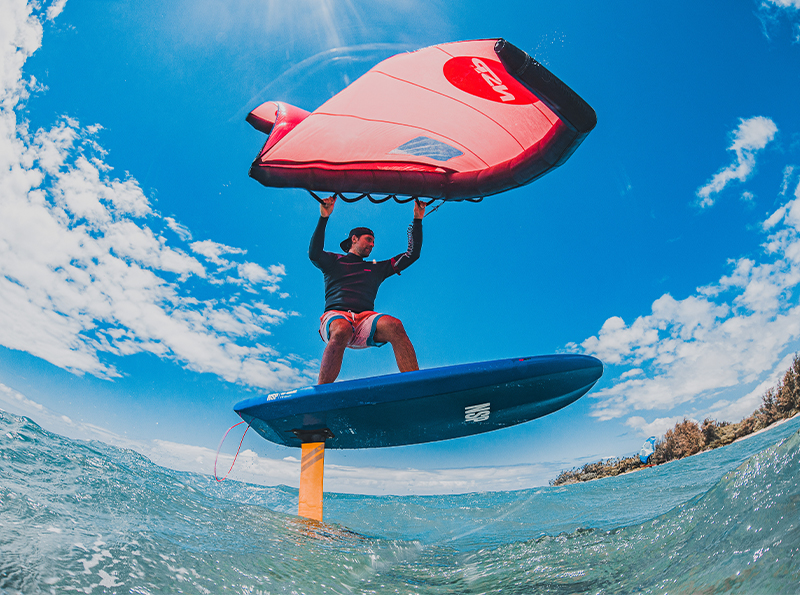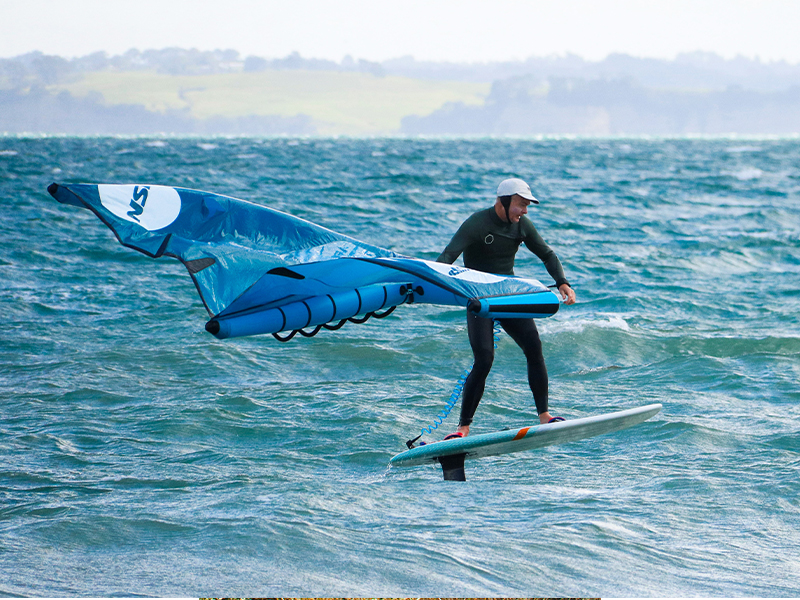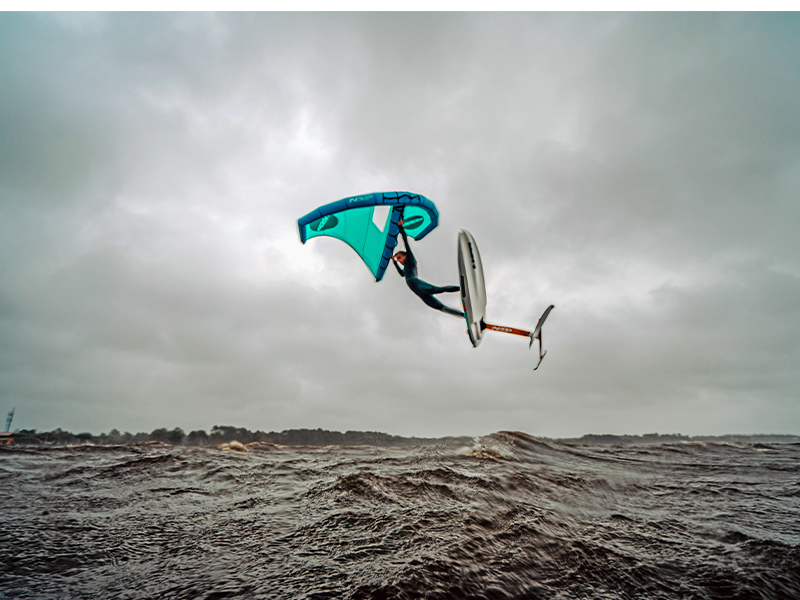The feeling of levitating over water while being powered by the wind is as incredible as it is addictive. Holding an inflatable wing and catching the breeze while standing on a board, with only an attached hydrofoil (referred to simply as a “foil”) in the water – this is what winging, or wing foiling, is all about. It’s the fastest growing water sport of a generation, and it’s here in Hong Kong!

An easier option
If you’re unfamiliar with wing foiling, imagine a collision between a kitesurfer and a windsurfer and from the ensuing carnage emerges a sleeker and more user-friendly waterborne package that requires less wind to work. There are many kiters and windsurfers forsaking their sports and taking up winging for this reason.
“Wing foiling adds another dimension to wind sports by merging the gap between windsurfing and kitesurfing. It has made conditions that aren’t very windy with no waves insanely fun,” says Hawaiian waterman and foiling pioneer Kai Lenny.
Another benefit? Less equipment is required. This means it’s an easier sport to learn as there are fewer things to think about and get tangled. It also makes it simple to carry equipment around. Think of the size of windsurfing boards, booms, sails and the variety and bulk of kitesurfing kites, cords and harnesses. With winging, it’s a board, foil and wing. Everything can be easily bagged and checked when travelling, and it’s all compact enough to fit into a small apartment or car, no roof racks required.
Growing interest
As to when wing foiling started, you’ll be hard pressed to find a video with winging prior to 2017. And the first commercial wing was only released in 2018. Since then, the sport has seen rapid growth with various disciplines branching off. In late 2020, the first freestyle event, with participants launching themselves and their equipment into multiple flip and spin combinations. People are now winging on flat water in lakes and harbours, and when there’s swell in the ocean they’re doing long-distance downwinders – going from one spot to another – following a coastline using the wind and open ocean swells.
Four-times world kitesurf champion Keahi De Aboitiz says, “I wasn’t sure how much I’d get into it in the beginning. But like a lot of people, I’m completely addicted and now it’s my go to activity for small waves. For me, the biggest allure is the same reason I got into foiling: the ability to ride tiny swells that you would never want to surf. The added benefit of winging is it allows you to get into a wave or swell much earlier with no need for paddling.
The beauty of hydrofoils is that they’re so efficient in creating lift that they don’t need a breaking wave to move, unlike surfboards. So unbroken, open ocean swells are accessible. Even without swell, the wing harnesses the wind, which gives you speed and elevates the foil quickly. Whether it’s wind or swell, your speed is nature-supplied.
Multiple world windsurfing champion Robbie Naish says that wings and foils have an almost perfect synergy; “I honestly think it will become the dominant wind-driven sport over the next decade. It checks all the boxes: simple, fun, fast.”
Getting started
Now, while this all sounds straightforward enough, there’s a bit of a learning curve. Well, a lot of learning curve, to be honest. The wing can be awkward to manage when you first start out. And the act of balancing on a rising foil needs to be mastered.
If you don’t have a foil or foil board, a great way to get the feel of a wing is on a skateboard – ideal if you’ve got a large, flat and empty concrete area around. Schools, parking lots and basketball courts are great options. Or, if there’s a lake, harbour or area of flat water in the vicinity, use a standup paddle board (SUP). They’re stable and easy to get back onto if – okay, when – you fall off. Trying on an SUP will give you an idea of the power of the wing.
Aussie waterman James Casey recommends beginners try stable wind conditions on flat water first. “Start with a big board and medium-sized foil and take it step by step. If you can get out three days in a row in good conditions, you will get it. Cycling is a great crossover to get your legs strong, and surfing is a great way to learn to read the waves and conditions. Between the two, you will be ready to foil.”
What you’ll need Wings:
These come in different sizes. The one you use will depend on your weight, the strength of the wind and how buoyant (i.e. how many litres) your board is. The stronger the wind, the smaller the wing. Wing sizes generally come in 3, 4, 5 and 6 metres. Something in the middle is suitable for beginners, and will cover an array of wind speeds from 10 to 30 knots.
Despite the odd-looking size of the wing, they’re pretty simple to inflate. Depending on the manufacturer, there’ll be one or two bladders along the leading edge and the centre strut. You’ll need a hand pump – your lungs aren’t going to cut it.
Foils and boards: There are many different types on the market, from beginner to complete professional setups. If you don’t want to invest too much to start with, there’s a good selection of secondhand equipment around – testament to winging’s rapid growth. Head online or to your nearest surf or water-sports store. Wing-specific boards are around four-and-a-half feet to six feet. Start on a large one (about 30 litres more than your weight), then move down in size as your skills improve.
Some tips
Keahi De Aboitiz says, “I’ve taught a little bit of winging now and I find it really helps if you break it down into two sports. Trying to learn everything at once can be very difficult and can result in some sketchy crashes. But if you can learn the basics of a foil or an e-foil (electric foil), it’s a lot easier to bring in the wing after that.”
“A lot of people liken wing foiling to snowboarding in powder,” he adds, “as it has that same feeling of smooth glide and drawn-out high-speed carves.”
Another frothing foiler is former Pipeline master and two-time world surfing champion Tom Carroll. He sums up the winging learning experience: “Don’t try to do it on your own. You’ll never get there with the time frame that we expect with anything in this day and age. We just want everything ‘now’! Dedicate hours into reprogramming the body and mind and you’ll start to feel it. All of a sudden, once you’ve got the winging going, you can play all over the place. A whole world of action opens up.”
As for the future of winging, “I can see it continuing to explode in popularity as it seems to bridge the gap across a lot of sports,” says Keahi, “The people who never wanted to learn to kite are much more interested in winging as it’s a little cheaper and requires less gear. It opens up new spots like small lakes or locations with tricky launches. You can even wing in the snow, with a snowboard or skis, on the ice with ice skates, or on a skateboard in the car park. I like to use it as a tool for chasing bigger waves on a foil.
From surf to flat water and from parking lots to snow and ice, the versatility and freedom winging offers is just too much of an allure to ignore!
Wing Foiling Resources
- Free downloadable guide: thefoilingmagazine.com/beginners-guide-to-wing-foiling
- Online tutorials: Cabrinha: cabrinha.com/blogs/news/cabrinha-wing-tutorial-series James Casey: caseyaus.com
- List of wing foiling schools around the world: globalwingsportsassociation.org/wingfoil-schools
- Lessons in Hong Kong: hiwindlover.com/pages/wing-rental
- Foil gear in Hong Kong: sharelifesports.com
Subscribe to Expat Living Magazine now so you never miss an issue.







